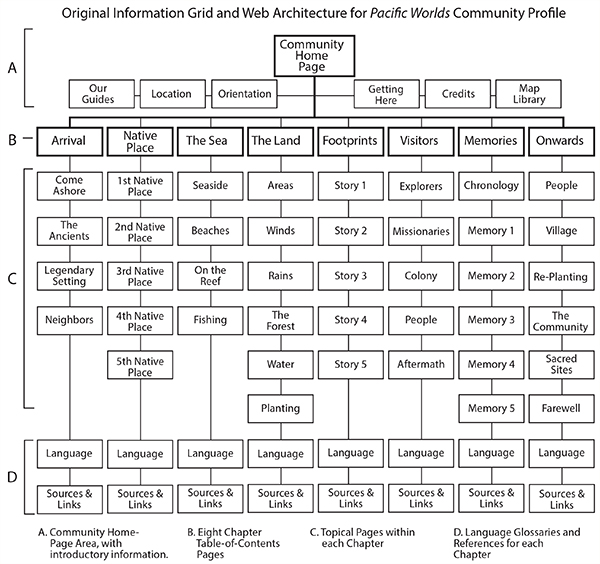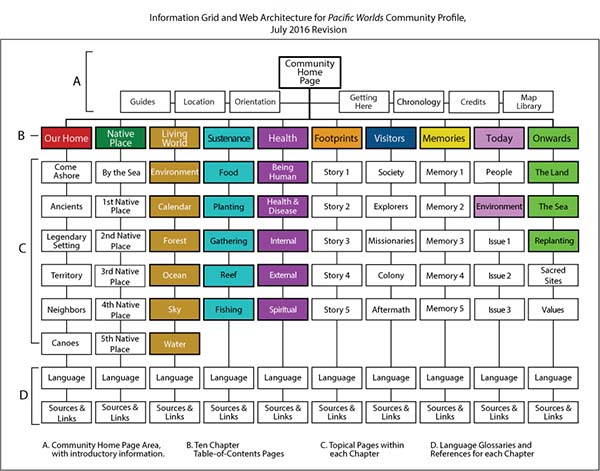Full Description of the new Template:
Chapter 1: Our Home
This project considers places in terms of layers. The Our Home chapter forms the most fundamental and ancient layer, often more rooted in legend than in local history. It explores the origins of that people in that locale, and of the place itself, with particular attention to the specific community or land division that is the focus for that website.
Chapter Two: Native Place
The Native Place chapter forms the second oldest layer of story and meaning. The format of this chapter is to consider six physical sites (or types of sites) whose characteristics are valuable in helping us understand the culture of this place prior to Western contact. The important criterion of this chapter is that these sites are historical, not legendary: actual people and practices are associated with them. (Sites that are strictly legendary are considered in the Footprints chapter). Through these sites, we learn about the workings of that culture, in that community, in that location. It does not tell us everything about that culture, but gives us some concrete examples and places to consider.
Chapter Three: The Living World
In this chapter, the community’s understanding of the natural world unfolds through a series of discussions. In Indigenous cultures, the relationship between the human world and the natural world is generally more complex and interconnected. What Western science sees as “species” might be understood as “nations” or races of beings with whom human society has relationships and responsibilities. This can extend to trees, rocks, streams and landforms, even to the earth itself. There are species of particular importance—for food, for medicine, for spiritual role or power, and other reasons. At the same time, each community describes and explains its environments within its own framework of understanding, pointing out differences and nuances that might be unclear to outsiders. This chapter gives an introduction to the wealth of environmental knowledge and understanding of Native communities.
Chapter Four: Sustenance
Nothing is more important than food, and food connects to many aspects of cultural life. For most people over the course of human existence, providing the daily food we need has been our major task. It is tied to the environment (what is provided there, what can be grown there); to the seasons (different foods available at different times of year); to the living beings that we eat (plant or animal); and to the social and cultural rituals of food preparation and eating. In this chapter, we ask the community to discuss foods of special importance that derive from five different areas or practices: planting, (forest) gathering, reef gathering, near-shore fish, and pelagic fish. Often there will be one crop or animal that is the most important—taro or breadfruit, e.g.—and other foods that supplement that, or which are consumed in other seasons. How are these foods obtained? What techniques and rituals are involved? How are they understood in their relationship to the culture?
Chapter Five: Health
Health is associated directly from food, but is also much more than that. Health is an entire science about being in the world, and how to be in the world in a proper, balanced way. It involves our interactions with other people and other beings, our duties and responsibilities, and our inner development. More than merely the absence of disease, it is a positive, growth-enhancing state. This chapter asks how each community conceives of health: what does it mean, how is it defined, how is it measured? What properties contribute to health, or detract from it?
Chapter Six: Footprints [storied places]
The Footprints chapter is for telling stories concerning places and place names. These are the marks left on the landscape not only by those who came before, but in some cases by gods and supernatural beings as they traveled this land. This chapter has been entitled “Footprints” to emphasize that such stories and names are the marks left on the landscape. Carlos Andrade, of the University of Hawai‘i Center for Hawaiian Studies, remarks that these storied places “provide lessons, examples, through the words and through the eyes of the stories and of our ancestors. Place names themselves are messages from the ancestors that contain warnings, or urgings to look at something important there. They're stories about how to live.” For this chapter, we try to choose five physical sites with which there are legendary associations. This differs from the Native Place chapter, which focuses on sites of human use or occupation. In this case, these may be certain rocks, or water holes, or landforms about which stories of legendary events are told.
Chapter Seven: Visitors
Visitors is the first of three “historical” layers. Since Western culture defines “historical” in terms of written history, these layers are very shallow compared to the many, many generations of cultural history that preceded written records. Hence it is only in this eighth chapter that we get to the point where history becomes written. This chapter explores the early contact period, usually up through the end of the 19th century. As with the rest of this project, the Visitors chapter aims to provide local perspectives on these historical periods, as a counter-balance to the Western perspectives usually found in textbooks and history books.
Chapter Eight: Memories
Memories is so called because the pages in this chapter are mostly recollections of major events that people still remember. Sometimes it goes a bit further back into written history, as necessary to keep the continuity of a community's story, but for the most part, this chapter brings us up through the 20th century to very near the present. As with the Native Place and Footprints chapters, the individual pages in this chapter will vary depending on what events are deemed most important by the community guides. Since this chapter is about recollections, it is important to bear in mind that these recollections are personal. Other people in the community may have different perspectives on these events. As always, these stories should be considered starting points, not ending points, of discussion.
Chapter 9: Today
All indigenous communities are faced with a range of issues and pressures today, from demographic changes to climate change. This chapter includes sections on People and the Environment, and then takes up three issues that members of the community point to as most critical.
(1) People: considers population changes. In these times of greater mobility, many communities are affected both by in-migration and out-migration, both of which have impacts on the society and the land. Who is there now? What is the make-up of the community, and what sort of dynamics does this bring about? What forces are at work to bring the community together, or to pull it apart? This page might also look at groups forming to address particular issues, or to preserve particular traditions.
(2) Environment: this section looks at those species—plant, animal, insect, marine—that have been introduced by humans, particularly since Western contact (“canoe plants” brought by the original settlers having long since become naturalized). What species, why, when, and what impacts? Of particular concern here is invasive species that threaten the indigenous ones.
(3-5) Issues: The issues presented in these three pages are determined through interviews with the community members. Pressing issues could be economic, environmental, political, or other.
Chapter 10: Onwards
“Onwards” suggests movement into the future. This chapter looks at present-day situations (at the time of interviews) in these communities, with particular focus on the preservation and perpetuation of cultural knowledge, environmental practices, and historical sites. How is this community changing, both in terms of people and environment, and how is it working to preserve and perpetuate its cultural and material resources?





